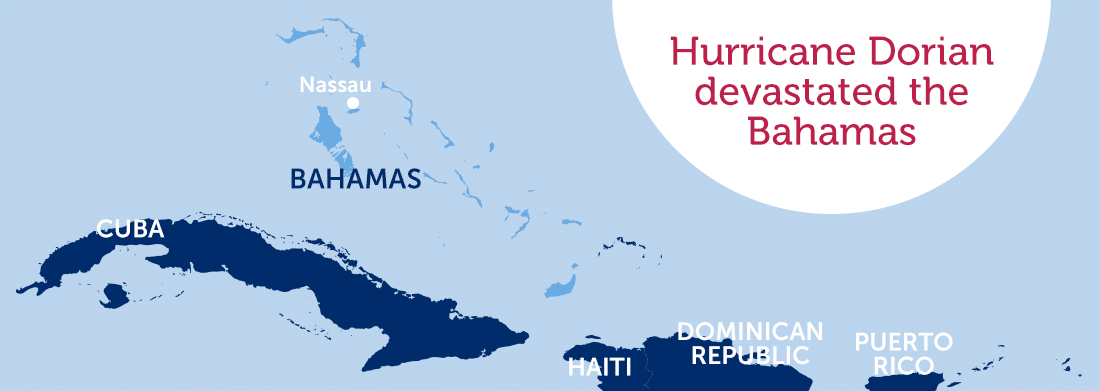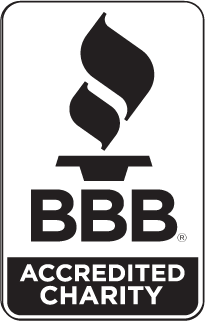Hurricane Dorian: What You Need To Know
On September 1, Hurricane Dorian slammed into the Bahamas as a massive Category 5 storm, causing catastrophic damage on Abaco and Grand Bahama Island. Project HOPE is on the ground meeting people’s medical needs and helping the islands prepare for the long recovery ahead. Get the facts about this storm and learn more about how you can help now.

One of the strongest Atlantic hurricanes on record
Hurricane Dorian entered the Caribbean as a tropical storm and rapidly intensified into one of the strongest Atlantic hurricanes ever recorded. After passing east of Puerto Rico, Dorian moved north toward the Bahamas and slammed into the Abaco Islands and Grand Bahama Island as a devastating Category 5 hurricane. Reports show absolute destruction on Abaco and Grand Bahama Island, where Dorian’s sustained winds reached 185 miles per hour — the strongest storm to ever hit the Bahamas.1
Project HOPE is on the ground in the Bahamas supporting emergency response efforts and helping the islands prepare for the long road to recovery.
Get The Facts: What You Need To Know and How To Help
About Hurricane Dorian
Hurricane Dorian was one of the strongest Atlantic hurricanes ever recorded and the strongest to ever hit the Bahamas. More than 76,000 people were affected across Grand Bahama and Abaco, and more than 13,000 houses on Abaco were destroyed. Two months after the storm, the death toll is still being tabulated as the clearing of debris continues.
How strong was Dorian when it made landfall? How does it compare to previous hurricanes? What are the greatest needs facing the Bahamas? Get the quick facts below.
How strong was Hurricane Dorian when it made landfall?
Hurricane Dorian hit the Bahamas as a Category 5 hurricane before making landfall in North Carolina as a Category 1 storm.
Dorian struck the Bahamas as a devastating Category 5 hurricane with wind gusts over 220 miles per hour. By the time it made landfall in North Carolina, its sustained winds had decreased to 90 miles per hour and the main threats from the storm were flooding and storm surge.
Dorian tied the record for the strongest storm ever recorded in the Atlantic and was the strongest to ever hit the Bahamas. Part of the reason the damage is so widespread is because Dorian slowed to a 1-mile-per-hour crawl over the islands, pounding them for nearly 48 hours with torrential rains and winds that can tear apart buildings.
What happened in the Bahamas?
Dorian has caused “unprecedented” damage on the Bahamian islands of Abaco and Grand Bahama Island, with entire communities destroyed by the historic storm.

Bahamas prime minister Hubert Minnis has said that the damage on the islands is “unprecedented” and that the Bahamas are in “the midst of a historical tragedy.”
The Abaco Islands and Grand Bahama Island in particular suffered catastrophic damage. The Abacos are a sparsely populated chain of islands, cays and rocks that are mostly inhabited by fishermen, manual laborers and Haitian immigrants. Whole towns have been wiped out on Great Abaco Island, and officials have warned that the death toll could be very high.
How does this storm compare to recent hurricanes?
Dorian is one of the strongest hurricanes ever recorded in the Atlantic and the first Category 5 storm to hit Grand Bahama Island.
Dorian’s sustained wind speeds when it made landfall in the Bahamas were 185 miles per hour—stronger than Hurricane Michael (2018), Hurricane Irma (2018) and Hurricane Maria (2017). Its sustained winds tied the record for landfall in the Atlantic, which was set in 1935.5 Before Dorian, a Category 5 storm had never hit Grand Bahama Island.
According to the Saffir Simpson Hurricane Wind Scale, Category 1 winds (Dorian’s status when it made landfall in North Carolina) can cause “very dangerous winds,” with power outages that could last for days. The Category 5 winds that hit the Bahamas are catastrophic and can level entire buildings.
What is the greatest need?
Even as the focus of the response shifts into long-term recovery, areas that suffered the highest levels of devastation still need basic supplies like food and clean water, and all health facilities on Abaco Island are in need of infrastructure repair and restoration.
With parts of Abaco and Grand Bahama Island suffering total devastation, many communities in the Bahamas will take years to rebuild. Recovery is slow as thousands of people remain displaced, and the Bahamas’ national minister of Social Services and Urban Development has said there is “a sense of urgency” to get people into more stable housing. The Red Cross estimates that as many as 13,000 homes may have been destroyed.
Shortly after the storm, many people evacuated from Abaco to New Providence Island, either to stay in shelters or with friends and family. For those on Abaco, however, the need is still immense: Every health facility on the island is in need of repair, and there are still widespread gas and electricity shortages. There is no way to buy food or water, and massive piles of debris line the roads.
What is Project HOPE doing to help?
Project HOPE has provided direct care to more than 1,300 patients in the Bahamas and distributed more than $719,000 in medicines and supplies. Today, we’re working with our partners to help meet the health needs of evacuees and support long-term recovery on Abaco.
Project HOPE has delivered essential medical supplies to Abaco’s Marsh Harbour Community Clinic, including gauze, bandages, diapers, cleaning supplies, insulin needles and phenobarbital. Additionally, we have delivered tens of thousands of hygiene kits donated by MAP International and the Church of Latter-day Saints to various shelters, as well as pharmaceuticals and supplies to the Ministry of Health.
In shelters in and around Nassau, HOPE has provided exams, wellness checks and referrals for evacuees with medical conditions like hyperglycemia, hypertension and bronchitis. Our team also provided health screenings for more than 600 evacuee children attending school in Nassau. In October, HOPE began implementing first-aid training for evacuees on New Providence Island and is working to expand the trainings to communities on Abaco.
More than 25 expert volunteers have been deployed to provide direct patient care in the Bahamas, including five physicians, two registered nurses and a nurse practitioner. In total, Project HOPE has provided direct care to more than 1,300 patients and distributed more than $719,000 in medicines and supplies. Our response is expected to go through at least the end of December.
Project HOPE has the ability to rapidly get shipments approved, cleared and distributed and continues to accept offers of donated goods, including medical equipment, medical supplies, pharmaceuticals, water purification units and hygiene kits.







